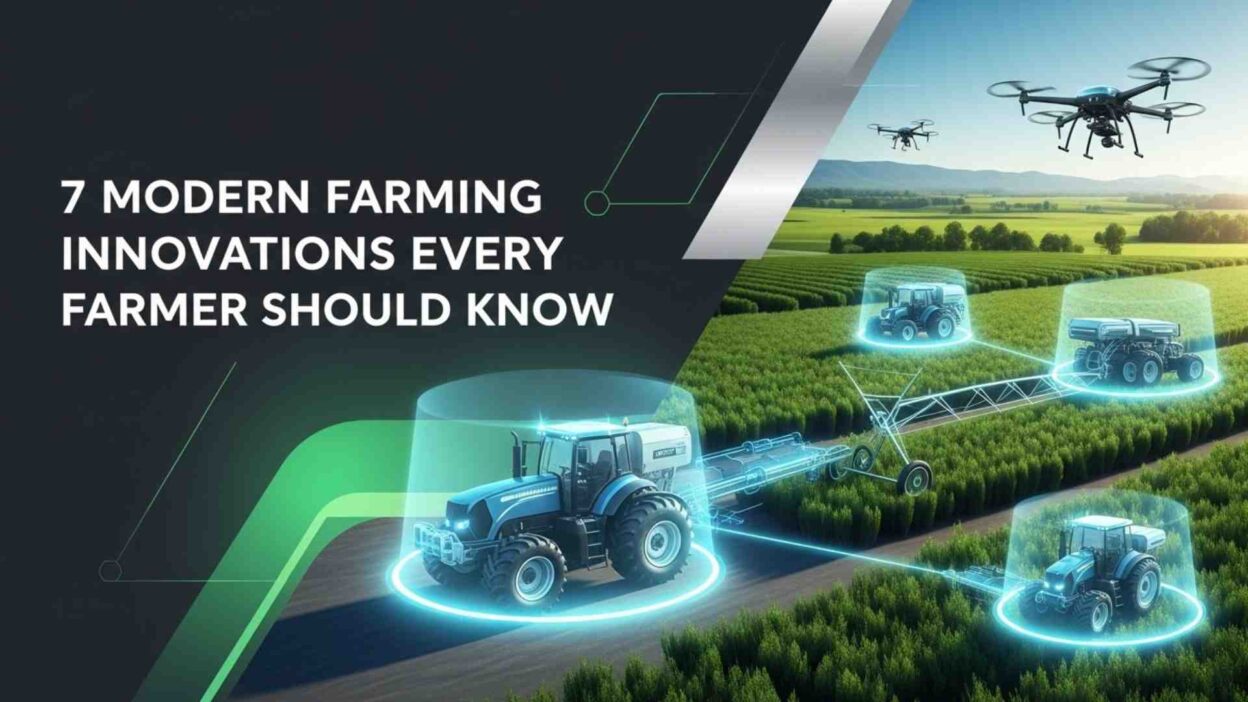TL;DR Agriculture stands at a critical crossroads today. Traditional farming methods face mounting challenges. Climate change affects crop yields unpredictably. Water scarcity threatens agricultural sustainability.
Table of Contents
Farmers need solutions that work right now. Technology offers answers to age-old problems. Modern farming techniques and innovations are transforming how we grow food. These advancements help farmers produce more with less.
The global population continues growing rapidly. Food demand will increase by 70% by 2050. Conventional approaches cannot meet this challenge. Smart farmers are embracing new technologies today.
This article explores seven groundbreaking innovations. Each technology addresses specific farming challenges. Real-world applications demonstrate proven results. Your farm can benefit from these advancements immediately.
Precision Agriculture and Smart Farming Systems
Precision agriculture revolutionizes field management completely. Sensors collect data from every square meter. GPS technology guides equipment with centimeter accuracy. Farmers make decisions based on concrete information.
Traditional farming treats entire fields uniformly. Precision agriculture recognizes variability within fields. Soil composition differs across your property. Water retention varies from spot to spot.
Modern farming techniques and innovations enable targeted interventions. Fertilizer goes exactly where crops need it. Water irrigation adjusts to soil moisture levels. Seeds get planted at optimal depths automatically.
GPS-Guided Tractors and Equipment
Autonomous tractors operate 24 hours a day. Human operators tire after long shifts. Machines maintain consistent performance endlessly. Fuel efficiency improves through optimized routes.
GPS guidance reduces overlap during planting. Every pass follows the previous one perfectly. Input waste decreases by 10-15% immediately. Cost savings accumulate quickly over seasons.
Older equipment upgrades with retrofit kits. You don’t need brand new machinery. Guidance systems are installed on existing tractors. Return on investment happens within two years.
Soil Sensors and Monitoring Systems
Underground sensors measure moisture continuously. Data uploads to cloud platforms automatically. Mobile apps display real-time conditions. Irrigation triggers only when necessary.
Nutrient sensors identify deficiencies early. Plants show stress symptoms too late. Proactive treatment prevents yield losses. Harvest quantities increase substantially.
pH monitoring maintains optimal growing conditions. Automated alerts notify about significant changes. Soil amendments apply at precise rates. Crop health improves measurably.
Variable Rate Technology Applications
Seed rates adjust based on soil productivity. High-yield areas receive more seeds. Poor areas get reduced planting density. Resource allocation optimizes across entire fields.
Fertilizer application follows prescription maps. Soil testing identifies nutrient needs spatially. Variable rate spreaders apply exact amounts. Over-application waste stops completely.
Modern farming techniques and innovations reduce environmental impact significantly. Nutrient runoff decreases dramatically. Groundwater contamination risks drop. Sustainable farming becomes economically viable.
Drone Technology for Crop Monitoring
Agricultural drones transform field scouting completely. Walking fields takes hours of labor. Drones survey hundreds of acres in minutes. Aerial perspectives reveal patterns invisible from ground level.
Multispectral cameras detect plant stress early. Healthy vegetation reflects light differently from stressed plants. Color-coded maps highlight problem areas precisely. Intervention happens before visible symptoms appear.
Thermal imaging identifies irrigation issues. Cold spots indicate excess water. Hot areas signal drought stress. Water management improves dramatically.
Aerial Surveying and Field Mapping
Drones create detailed topographic maps. Elevation data guides drainage planning. Low spots where water pools become obvious. Infrastructure improvements target specific locations.
Crop counting happens automatically through image analysis. Emergence rates are calculated accurately. Replanting decisions rely on hard data. Guesswork disappears from stand establishment.
Boundary surveys update property records. GPS coordinates document field edges precisely. Acreage calculations become completely accurate. Crop insurance claims process faster.
Early Disease and Pest Detection
Disease outbreaks start in small patches. Early detection enables targeted treatment. Drones identify infection zones before spreading. Chemical applications treat only affected areas.
Insect damage shows in vegetation indices. Stress patterns indicate pest activity. Scouting efforts focus on problem zones. Prevention costs less than widespread treatment.
Weed mapping guides herbicide application. Dense weed patches receive extra treatment. Clean areas get minimal or no chemicals. Herbicide resistance develops more slowly.
Spraying and Application Services
Drone sprayers reach difficult terrain easily. Steep hillsides challenge ground equipment. Wet fields can’t support heavy machinery. Aerial application continues despite conditions.
Precision spraying reduces chemical use significantly. Droplet size optimizes for target pests. Wind drift decreases through low-altitude application. Environmental concerns diminish substantially.
Modern farming techniques and innovations include autonomous drone operations. Pre-programmed flight paths ensure complete coverage. Battery swaps happen automatically at charging stations. Human supervision becomes minimal.
Vertical Farming and Controlled Environment Agriculture
Vertical farming produces crops in stacked layers. Urban warehouses transform into farms. Abandoned buildings gain new purpose. Food grows near consumer markets.
LED lighting replaces natural sunlight. Wavelengths optimize for plant growth. Energy efficiency improves yearly. Operating costs decrease continuously.
Climate control eliminates weather variables. The temperature stays perfect year-round. Humidity levels are constant. Growing seasons become irrelevant.
Indoor Growing Systems
Hydroponic systems grow plants without soil. Nutrient solutions feed roots directly. Water recirculates in closed loops. Consumption drops by 90% compared to field farming.
Aeroponic systems mist roots with nutrients. Oxygen exposure maximizes growth rates. Crops mature 30% faster than traditional methods. Turnover increases substantially.
Aquaponic systems combine fish and plants. Fish waste provides plant nutrients. Plants filter water for fish. Closed-loop systems minimize environmental impact.
Climate Control and Automation
HVAC systems maintain ideal temperatures. Computers adjust conditions automatically. CO2 levels enhance photosynthesis. Growth rates accelerate noticeably.
Humidity control prevents disease. Fungal problems disappear in dry conditions. Pest pressure reduces dramatically. Chemical treatments become unnecessary.
Automated nutrient delivery feeds plants precisely. pH sensors maintain optimal ranges. EC meters monitor fertilizer concentration. Computer algorithms optimize feeding schedules.
Space Optimization Strategies
Vertical stacking multiplies the growing area. Ten layers produce ten times the yield. Square footage generates maximum output. Urban land costs become manageable.
Rolling benches increase plant density. Aisles appear only when needed. The growing area expands by 30%. Space efficiency maximizes profitability.
Modern farming techniques and innovations enable year-round production. Seasonal limitations vanish completely. Supply stays consistent twelve months a year. Market prices stabilize through constant availability.
Internet of Things and Connected Farming
IoT sensors blanket modern farms. Everything connects to central systems. Data flows continuously from fields. Decision-making improves through comprehensive information.
Weather stations monitor microclimates precisely. Temperature varies across your property. Local data beats regional forecasts. Frost protection activates at exact moments.
Equipment sensors predict maintenance needs. Vibration patterns indicate bearing wear. Oil analysis reveals engine problems early. Breakdowns happen less frequently.
Wireless Sensor Networks
Soil moisture sensors communicate wirelessly. Battery life extends for entire seasons. Mesh networks cover large properties. Installation requires no trenching.
Tank level monitors prevent running dry. Automatic alerts notify about low levels. Refill orders happen proactively. Operations never stop unexpectedly.
Gate sensors track livestock movement. Pasture rotation optimizes automatically. Grazing patterns become visible. Range management improves measurably.
Data Analytics and Farm Management Software
Cloud platforms aggregate all sensor data. Analytics identify trends across seasons. Yield predictions become increasingly accurate. Planning improves through historical analysis.
Financial management integrates with operations. Input costs link to specific fields. Profitability analysis happens at the field level. Investment decisions rely on concrete numbers.
Labor management tracks worker productivity. Task completion rates become visible. Bottlenecks get identified quickly. Efficiency improvements happen systematically.
Automated Irrigation and Feeding Systems
Smart irrigation controllers use weather forecasts. Systems skip watering before predicted rain. Water waste stops immediately. Conservation happens automatically.
Drip irrigation delivers water to the roots directly. Evaporation losses become minimal. Fertilizer is injected into irrigation lines. Nutrients apply exactly when plants need them.
Modern farming techniques and innovations include livestock feeding automation. Rationing systems dispense precise amounts. Feed waste decreases significantly. Animal health improves through consistent nutrition.
Biotechnology and Advanced Seed Development
Genetic research accelerates crop improvement. Traditional breeding takes decades. Modern techniques achieve results in years. New varieties reach farmers faster.
CRISPR technology edits genes precisely. Desired traits insert without foreign DNA. Regulatory pathways simplify considerably. Adoption accelerates rapidly.
Drought-resistant varieties withstand water stress. Yields remain stable during dry periods. Climate adaptation becomes possible. Risk decreases for farmers.
Disease-Resistant Crop Varieties
Pest-resistant plants reduce insecticide needs. Natural defenses protect against insects. Chemical applications decrease substantially. Environmental impact drops dramatically.
Disease-resistant varieties prevent crop losses. Fungal resistance eliminates fungicide sprays. Bacterial resistance saves entire harvests. Reliability increases significantly.
Virus-resistant plants maintain yields. Traditional varieties succumb to infections. Modern genetics provides immunity. Production security improves.
Nitrogen-Fixing and Nutrient-Efficient Plants
Nitrogen-fixing varieties reduce fertilizer needs. Symbiotic bacteria produce nitrogen naturally. Input costs decrease substantially. Soil health improves over time.
Nutrient-efficient varieties extract minerals better. Root systems explore soil more thoroughly. Lower fertilizer rates maintain yields. Profitability increases noticeably.
Stress-tolerant varieties handle difficult conditions. Heat tolerance preserves yields. Salt tolerance enables marginal land use. The growing area expands significantly.
Yield Enhancement Technologies
Hybrid vigor boosts production substantially. Heterosis effects increase yields by 20-30%. Seed costs pay for themselves easily. Profitability improves consistently.
Photoperiod-insensitive varieties adapt widely. Geographic flexibility increases. Multiple growing regions become viable. Market opportunities expand.
Modern farming techniques and innovations include accelerated breeding programs. Marker-assisted selection speeds development. Genomic prediction identifies superior genetics. Improvement happens exponentially faster.
Robotics and Autonomous Farm Equipment
Agricultural robots handle repetitive tasks. Fruit picking requires careful handling. Robots work gently and consistently. Labor shortages become irrelevant.
Weeding robots identify and remove weeds. Computer vision distinguishes crops from weeds. Mechanical or laser removal avoids chemicals. Organic certification becomes achievable.
Harvesting robots operate continuously. Night harvesting beats daytime heat. Product quality improves. Market premiums reward excellence.
Automated Harvesting Systems
Strawberry harvesters use gentle grippers. Ripeness sensors select perfect berries. Bruising decreases dramatically. Shelf life extends noticeably.
Lettuce harvesters cut and package in the field. Labor costs drop by 50%. Harvest speed triples traditional methods. Freshness improves substantially.
Apple harvesters reach difficult branches. 3D vision maps the tree structure. Every apple gets picked. Yield recovery increases significantly.
Robotic Weeding and Crop Maintenance
Laser weeders kill plants precisely. Targeted energy destroys growing points. Chemical herbicides become unnecessary. Organic premium prices justify investment.
Mechanical cultivators work between crop rows. GPS guidance prevents crop damage. Soil disturbance controls weeds effectively. Multiple passes replace a single herbicide application.
Spot sprayers target individual weeds. Camera systems identify weed species. Appropriate herbicides apply selectively. Chemical use drops 90%.
Autonomous Transport and Logistics
Self-driving grain carts follow harvesters. Operators focus on harvesting equipment. Efficiency improves substantially. Harvest windows maximize.
Material handlers move supplies automatically. Seed and fertilizer transport to the equipment. Downtime decreases dramatically. Planting progress accelerates.
Modern farming techniques and innovations reduce labor requirements significantly. Rural workforce shortages matter less. Productivity per worker multiplies. Farming becomes viable for fewer people.
Renewable Energy Integration on Farms
Solar panels generate electricity cheaply. Installation costs dropped 80% in ten years. Feed-in tariffs provide a steady income. Energy independence increases.
Wind turbines suit open farmland perfectly. Lease payments provide passive income. Tax incentives improve returns. Diversification reduces risk.
Biogas digesters convert waste to energy. Manure becomes a valuable resource. Methane powers generators. Grid sales generate revenue.
Solar-Powered Irrigation and Operations
Photovoltaic systems power irrigation pumps. Remote locations need no grid connection. Operating costs drop to near zero. Water access expands dramatically.
Solar tracking systems increase efficiency. Panels follow the sun’s movement. Energy production increases 25-30%. Payback periods shorten.
Battery storage enables 24-hour operation. Excess daytime generation stores. Nighttime irrigation continues. Flexibility increases substantially.
Biofuel Production and Energy Independence
On-farm biodiesel production uses vegetable oil. Fuel costs decrease substantially. Equipment runs on homegrown fuel. Energy security improves.
Ethanol production converts grain into fuel. Distiller’s grains feed livestock. Multiple revenue streams emerge. Profitability increases.
Biogas from manure powers generators. Electricity runs farm operations. Excess sells to the grid. Waste becomes a profit center.
Sustainable Energy Economics
Government incentives offset installation costs. Tax credits reduce investment needs. Grants support renewable projects. Financial barriers are lower.
Energy sales provide a steady income. Power purchase agreements lock rates. Revenue predictability improves. Banks favor renewable projects.
Modern farming techniques and innovations include energy independence strategies. Fossil fuel price volatility matters less. Operating cost predictability increases. Long-term viability improves.
Blockchain and Agricultural Transparency
Blockchain technology creates permanent records. Transaction history becomes tamper-proof. Supply chain tracking gains credibility. Consumer trust increases.
Food provenance verification attracts premiums. Organic certification becomes verifiable. Origin claims to gain credibility. Marketing advantages multiply.
Smart contracts automate payments. Crop delivery triggers automatic payment. Intermediary delays disappear. Cash flow improves significantly.
Supply Chain Traceability
Every transaction is recorded on the blockchain. Harvest date becomes a permanent record. Transportation tracking continues unbroken. Retail arrival documents completely.
Contamination sources are identified instantly. Recall precision improves dramatically. Food safety incidents are resolved faster. Liability is clarified immediately.
Quality metrics are recorded at each step. Temperature exposure tracks continuously. Storage conditions document permanently. Premium justification becomes transparent.
Direct-to-Consumer Marketing Platforms
Blockchain enables farm-to-table verification. Consumers verify origin independently. Middleman markups disappear. Farmer margins improve substantially.
Cryptocurrency payments settle instantly. International sales simplify greatly. Currency conversion happens automatically. Global markets open.
Tokenization enables crowd-investment. Farms raise capital from supporters. Community ownership builds loyalty. Marketing becomes organic.
Carbon Credit and Sustainability Tracking
Carbon sequestration becomes measurable. Blockchain documents farming practices. Carbon credits generate automatically. Environmental markets compensate conservation.
Regenerative agriculture gets rewarded. Soil health improvements track permanently. Ecosystem services gain monetary value. Sustainability becomes profitable.
Modern farming techniques and innovations prove environmental stewardship. Transparent documentation builds brand value. Premium markets reward verified practices. Profitability aligns with sustainability.
Frequently Asked Questions
What are the most cost-effective modern farming innovations for small farms?
Soil sensors and GPS guidance offer immediate returns. Retrofit kits cost $5,000 to $15,000. Input savings pay for themselves within two years. Drip irrigation improves efficiency at a low cost. Used drones start around $3,000. Cloud-based farm management software charges monthly fees. Small-scale hydroponics fits urban locations. Solar panels qualify for substantial incentives.
Are these farming innovations environmentally sustainable?
Most innovations reduce environmental impact significantly. Precision application cuts chemical use 40-60%. Water conservation improves through smart irrigation. Renewable energy eliminates fossil fuel dependence. Biotechnology reduces pesticide needs. Vertical farming uses minimal land. Blockchain rewards conservation practices. Sustainability and profitability align increasingly.
How can traditional farmers transition to modern methods?
Start small with one technology. Master it before adding more. Government grants support adoption. Equipment dealers offer financing. Cooperative purchasing reduces costs. Demonstration farms show results. Extension services provide guidance. Gradual transition minimizes risk.
What is the return on investment for farming technology?
ROI varies by technology and scale. Precision agriculture returns investment in 2-3 years. Solar panels pay back in 5-7 years. Drones return investment within one season. Automated irrigation saves 20-30% on water. Labor automation shows immediate savings. Yield improvements boost revenue substantially. Long-term profitability improves dramatically.
Read More: Top AI Voice Assistant Use Cases for Smarter Call Centers
Conclusion

Agriculture faces unprecedented challenges worldwide. Climate change threatens traditional farming methods. Water scarcity limits production capabilities. Labor shortages strain rural operations. Modern farming techniques and innovations provide comprehensive solutions. Technology addresses every major challenge.
Precision agriculture optimizes resource use. Drones revolutionize field monitoring completely. Vertical farming multiplies production capacity. IoT connectivity enables real-time management. Biotechnology develops resilient crop varieties. Robotics solves labor shortage problems.
Small farms benefit as much as large operations. Scalable solutions fit every size. Technology democratizes advanced capabilities. Success doesn’t require massive capital. Consumer preferences favor sustainable practices. Premium markets reward environmental stewardship. Transparency builds brand loyalty. Technology enables verification completely. Food security depends on agricultural innovation. A growing population needs more food. Available farmland decreases yearly. Productivity must increase dramatically.
Technology is more accessible than ever. Benefits appear quickly after adoption. Profitability improves year after year. The agricultural revolution is happening now. Modern farming techniques and innovations define the future. Farmers who adapt will thrive. Those who resist will struggle.





